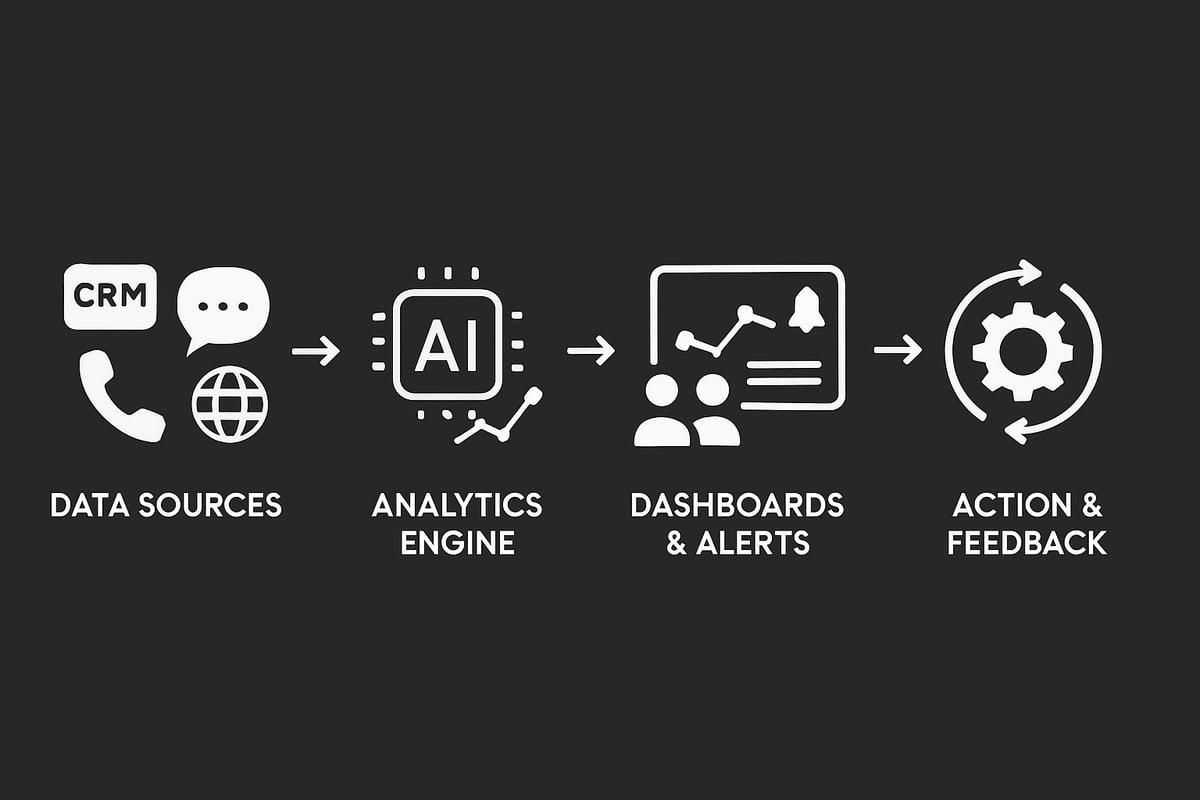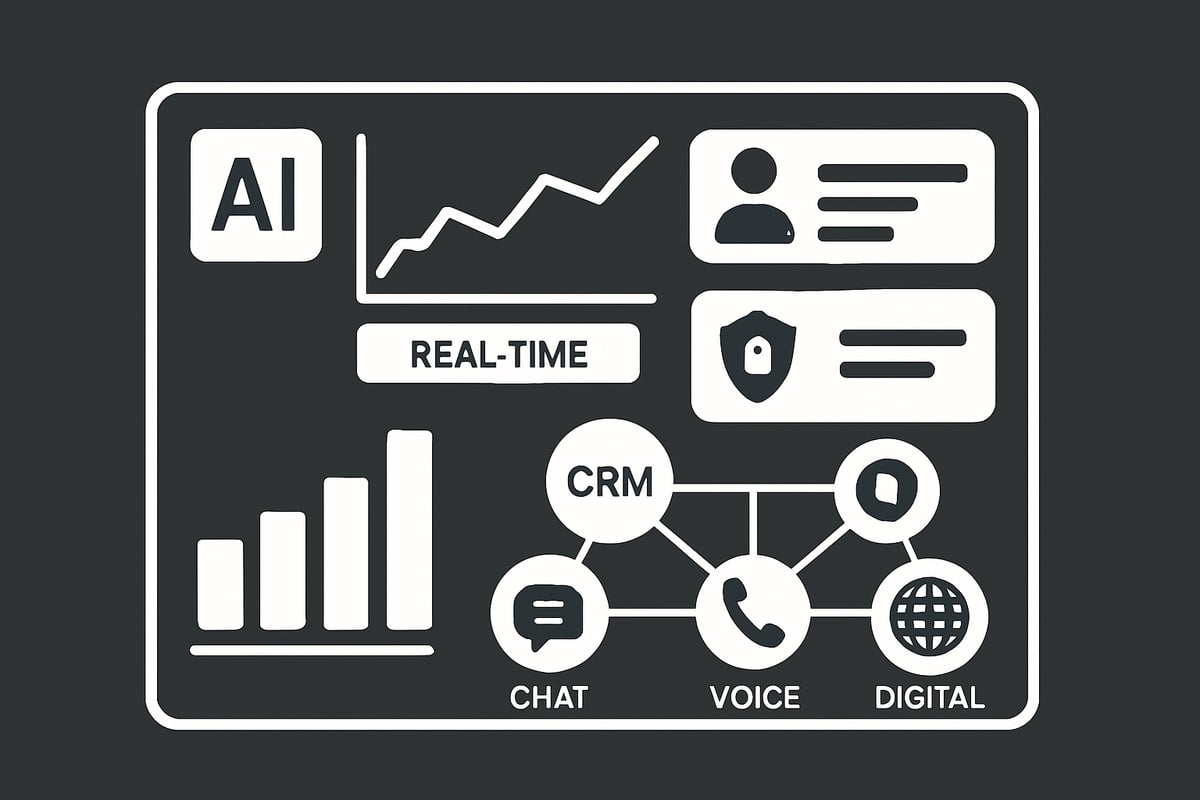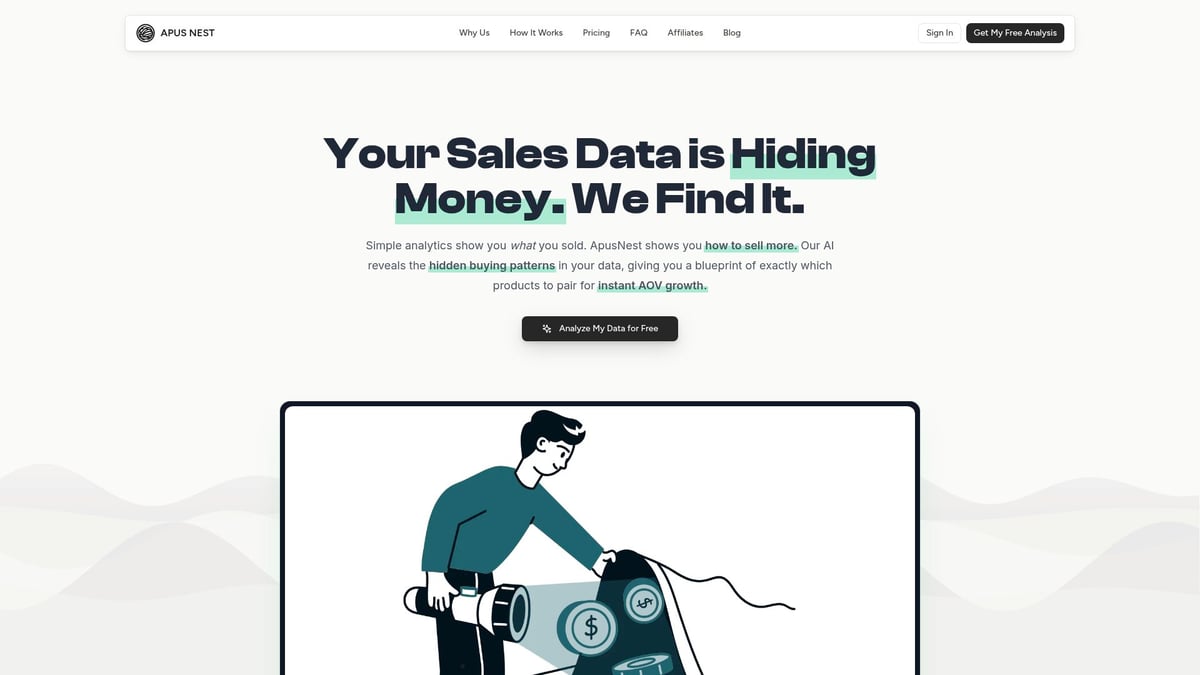By 2025, global customer data generation will surpass 175 zettabytes, creating both unprecedented opportunities and significant challenges for businesses. With this surge, many organizations struggle to transform raw data into actionable strategies that drive measurable results.
As analytics become more complex, the ability to extract meaningful insights is now a critical differentiator. Customer insights analytics stands at the center of this transformation, shaping smarter business strategies, elevating customer experiences, and directly impacting revenue growth.
This guide delivers a comprehensive roadmap for 2025, equipping you with definitions, practical workflows, essential tools, solutions to common pitfalls, emerging trends, and real-world examples. Empower your business to fully unlock the value of customer insights analytics and stay ahead in a data-driven world.
Understanding Customer Insights Analytics in 2025
Businesses today are flooded with more customer data than ever. Yet, extracting real value requires more than just collecting numbers—it demands actionable understanding. In this section, we break down what customer insights analytics really means in 2025 and why it matters for every organization aiming for growth.

Defining Customer Insights and Analytics
Customer insights analytics starts with a clear distinction: customer analytics tells you what happened, while customer insights explain why it happened. In other words, analytics might show a drop in sales, but insights uncover that confusing mobile checkout processes are driving customers away.
Definition: Customer insights are meaningful interpretations of customer data that reveal underlying behaviors, preferences, and needs. For example, Walmart discovered a 30% cart abandonment rate traced back to mobile checkout confusion, prompting a redesign that improved conversions.
The key difference is actionability. Data alone is not enough—customer insights analytics must drive business decisions. Over time, the field has evolved from basic reporting to sophisticated, AI-powered systems. Today, organizations leverage machine learning to move beyond surface-level metrics and uncover deep, actionable insights.
| Aspect | Customer Analytics | Customer Insights |
|---|---|---|
| Focus | What happened | Why it happened |
| Example | Cart abandonment rate | Reason for abandonment |
| Output | Metrics, reports | Recommendations, actions |
The Value Proposition of Insights Analytics
Customer insights analytics enables smarter, data-driven decisions across marketing, sales, and service. With 63% of consumers now expecting companies to listen and act on their feedback, the stakes are higher than ever.
The impact is measurable. Strong customer insights analytics programs lead to higher retention, deeper loyalty, and increased lifetime value. Companies that excel in this area consistently outperform peers in customer satisfaction and revenue growth. Ultimately, insights transform raw data into strategic advantage.
Types of Customer Insights Data
Modern customer insights analytics draws from a wide range of data sources, such as:
- Direct feedback (surveys, reviews)
- Service interactions (calls, chats)
- Digital behaviors (website visits, purchase history)
- Unsolicited feedback (social media posts)
This data comes in both structured (ratings, transaction logs) and unstructured (comments, voice recordings) forms. Integrating these touchpoints creates a unified customer view, essential for delivering relevant experiences. For e-commerce, market basket analysis in e-commerce is a prime example of using transaction data to reveal actionable patterns.
The Evolution of Customer Insights (Historical Perspective)
The journey of customer insights analytics has accelerated rapidly. Before the 1950s, businesses relied on the “art of listening.” The rise of market research brought structured surveys and focus groups. The digital revolution introduced online analytics and sentiment analysis.
In the past decade, AI-driven predictive modeling and real-time analytics have transformed the landscape. Today, change happens faster than ever, empowering organizations to adapt, personalize, and compete at a new level.
The Customer Insights Analytics Process: From Data to Action
Unlocking value from customer insights analytics in 2025 requires a structured, repeatable process that turns raw data into real business outcomes. Let’s break down each step of the analytics-to-action workflow, explore tools and best practices, and highlight common pitfalls to avoid as you transform data into decisions.

Step 1: Data Aggregation and Integration
The foundation of customer insights analytics is robust data aggregation. Organizations collect information from diverse sources: CRM systems, QA platforms, speech analytics tools, and digital touchpoints like websites or mobile apps.
To ensure data is actionable, companies must focus on clean, consistent, and connected repositories. Data silos are a persistent challenge, often leading to incomplete or fragmented customer perspectives.
Consider a contact center that integrates call transcripts, satisfaction scores, and purchase history into a unified platform. This approach enables seamless access and more holistic customer insights analytics.
Best practices include:
- Centralizing data using cloud-based data lakes or integration platforms.
- Standardizing formats and cleansing data to improve quality.
- Automating data pipelines for real-time updates.
A unified data environment accelerates insight generation and empowers teams to move quickly from collection to analysis.
Step 2: Analysis and Insights Generation
Once data is centralized, the next phase leverages AI and advanced analytics to identify patterns, trends, and anomalies. Techniques such as clustering, sentiment analysis, predictive modeling, and journey mapping are essential for discovering actionable insights.
Real-time analytics play a critical role, allowing businesses to respond instantly to emerging issues or opportunities. For example, Mastercard used analytics to detect increased call volumes linked to a confusing mobile feature, enabling rapid intervention.
For organizations seeking deeper strategies, Advanced Market Basket Analysis Strategies demonstrates how customer insights analytics can surface hidden product relationships and drive targeted actions.
The key is ensuring every insight is actionable and tied to KPIs. This step transforms raw data into strategic intelligence that can guide business decisions.
Step 3: Distributing Insights to Stakeholders
Effective customer insights analytics doesn’t stop at discovery—it requires seamless distribution to the right teams. Automated dashboards and tailored reports ensure that product managers, marketers, and service leaders receive relevant insights specific to their roles.
Role-based dashboards allow decision-makers to focus on what matters most to them. Timely delivery is crucial; insights must reach stakeholders before the opportunity to act passes.
For example, automated alerts can notify product managers when negative sentiment spikes, prompting immediate action. This targeted distribution enables faster responses and ensures insights are not lost in the shuffle.
Automating the flow of information helps organizations maximize the impact of their customer insights analytics investments.
Step 4: Action and Outcome Tracking
Turning insights into results is the ultimate goal of any customer insights analytics initiative. This step involves implementing actions—such as process improvements, targeted campaigns, or product updates—based on the insights delivered.
Tracking outcomes is essential for measuring effectiveness. Techniques include A/B testing, KPI monitoring, and establishing feedback loops to refine future analysis.
Continuous improvement is the hallmark of high-performing organizations. By using new data to inform the next cycle, businesses create an agile environment where customer insights analytics drives ongoing growth.
Agility and measurement ensure that every action is aligned with business goals and delivers tangible results.
Common Pitfalls in the Process
Despite best intentions, organizations can stumble in their customer insights analytics journey. Common pitfalls include data overload, which leads to analysis paralysis, and delays in sharing insights, causing missed opportunities.
Other challenges:
- Misalignment between insights and business objectives.
- Siloed teams and fragmented data sources.
- Lack of ownership over the insights-to-action workflow.
Solutions involve fostering cross-functional collaboration, adopting integrated platforms, and clearly defining roles and responsibilities. By addressing these issues, companies can ensure their customer insights analytics initiatives translate into sustainable value.
Staying vigilant against these pitfalls ensures the analytics process remains efficient, actionable, and impactful.
Key Technologies and Tools Powering Customer Insights Analytics
In 2025, the backbone of customer insights analytics lies in sophisticated technologies and purpose-built tools. Businesses must harness these solutions to transform massive volumes of raw data into actionable intelligence. The right mix of platforms and innovations determines how quickly and effectively organizations can respond to customer needs.

AI and Machine Learning in Customer Insights
Artificial intelligence is revolutionizing customer insights analytics by identifying patterns, predicting behaviors, and extracting meaning from complex data. Machine learning algorithms process millions of interactions, surfacing trends and anomalies that would be impossible to spot manually.
Natural language processing (NLP) enables businesses to analyze unstructured feedback from reviews, call transcripts, and social channels. Automated clustering groups similar comments, making it easier to pinpoint recurring themes or pain points.
For a deeper dive into how AI and machine learning are transforming this space, see AI and Analytics for E-Commerce.
These capabilities not only accelerate insight generation but also ensure that findings are actionable and aligned with business KPIs.
Real-Time Analytics and Dashboards
Real-time analytics empower organizations to monitor customer journeys as they unfold. Modern dashboards provide customizable key performance indicators (KPIs), journey mapping, and channel analytics, giving every team immediate visibility into customer behavior.
Features like automated alerts and Sankey flow visualizations ensure that relevant insights reach the right stakeholders at the right moment. Export functions allow teams to extract up to 50,000 records for deeper analysis or integration with other systems.
By leveraging real-time dashboards, companies can act swiftly on customer insights analytics, closing the gap between discovery and decision.
Data Integration Platforms
Seamless data integration is crucial for a unified customer view. Platforms connect data from CRM systems, QA tools, speech analytics, and digital channels, breaking down silos and centralizing information.
Unified data lakes and robust APIs enable consistent, clean, and connected repositories. This integration supports advanced analytics and ensures that insights are based on a comprehensive dataset.
With effective integration, customer insights analytics becomes more reliable, reducing manual data stitching and the risk of incomplete analysis.
Role-Based Reporting and Automation
Role-based reporting tailors insights for executives, managers, and frontline teams. Automated dashboards deliver relevant metrics to each user, streamlining decision-making and eliminating information overload.
Workflow automation distributes insights and recommended actions instantly, while outcome tracking ensures that every change is measured in real time.
This targeted approach ensures that customer insights analytics drives concrete business outcomes, fostering accountability and agility across the organization.
Privacy, Security, and Compliance
As data privacy regulations evolve, secure handling of customer data is non-negotiable. Advanced analytics tools incorporate privacy-by-design principles, supporting compliance with GDPR, CCPA, and emerging standards.
Best practices include encryption, access controls, and transparent customer communication. Organizations use these measures to build trust and maintain the integrity of customer insights analytics.
Embedding security at every step safeguards both customers and the business from risk.
Emerging Tools for 2025
The landscape of customer insights analytics is rapidly evolving. Predictive journey orchestration uses AI to anticipate customer needs and automate next-best actions. Auto QA and AI-powered coaching enhance frontline performance management.
Integration with enterprise platforms—such as CRM, CCaaS, and e-commerce solutions—ensures analytics tools fit seamlessly into existing workflows. Gamification and self-service capabilities further democratize access to insights.
These innovations position customer insights analytics as a strategic driver of growth, efficiency, and competitive advantage.
Overcoming Common Challenges in Customer Insights Analytics
Organizations face a new wave of challenges as customer insights analytics becomes central to business strategy. While the promise of data-driven decision-making is real, realizing its full potential means tackling persistent obstacles at every stage. Let’s explore the most pressing issues and actionable strategies for overcoming them.
The Data Deluge: Managing Volume and Complexity
In 2025, the sheer volume of customer data is staggering, with organizations navigating over 175 zettabytes. This exponential growth can be overwhelming, making it difficult to extract meaningful signals from the noise.
To address this, businesses need clear prioritization frameworks. Focus on high-impact KPIs and filter out irrelevant data. Use advanced analytics tools to automate data cleaning and reduce manual effort. By aligning your data strategy with business objectives, you can ensure customer insights analytics delivers value without drowning in complexity.
Breaking Down Data Silos
Fragmented data sources remain a top barrier in customer insights analytics. Disconnected CRM systems, QA platforms, and speech analytics tools result in incomplete customer views and redundant manual work.
To overcome silos, invest in integrated analytics platforms and unified dashboards. API-driven architectures enable seamless data flow across departments. Encourage cross-functional collaboration by sharing insights organization-wide. This approach not only improves data quality but also ensures everyone acts from a single source of truth.
Timeliness and Relevance of Insights
The window for acting on insights is often short. When customer insights analytics fails to deliver in real time, missed opportunities and poor experiences follow.
Implement real-time analytics solutions that provide instant alerts and dynamic dashboards. Automate insight distribution to ensure the right teams receive timely, relevant information. Agile workflows accelerate response times, transforming insights into immediate business value.
Actionability and Organizational Alignment
Not all insights are created equal. If insights from customer insights analytics lack clear action steps or don’t align with business goals, progress stalls.
Tie every insight to a specific business objective or operational plan. Develop clear playbooks that translate insights into process improvements, marketing campaigns, or product updates. Foster a culture of accountability, where teams own the insights-to-action workflow and regularly review outcomes.
Change Management and Adoption
Adopting new analytics tools and processes can meet resistance. Employees may be wary of unfamiliar technology or skeptical about its value.
Effective change management starts with leadership buy-in and transparent communication. Offer hands-on training and highlight quick wins to demonstrate the impact of customer insights analytics. Empower teams with user-friendly tools, building confidence and accelerating adoption across the organization.
Measuring and Communicating Impact
To sustain momentum, businesses must prove the ROI of customer insights analytics. Set up feedback loops that track the impact of actions using KPIs and case studies.
Leverage metrics like average order value and customer retention as benchmarks for success. For a deeper dive into how these metrics drive strategic decisions, see Understanding AOV and Customer Data. Share results broadly to reinforce the value of insights-driven actions and refine future strategies based on measurable outcomes.
Trends and Innovations Shaping Customer Insights Analytics in 2025
The landscape of customer insights analytics is rapidly transforming as new technologies and market expectations emerge. In 2025, businesses must keep pace with these trends to stay relevant, competitive, and truly customer-centric.
AI-Driven Automation and Predictive Analytics
Artificial intelligence is at the core of modern customer insights analytics. AI algorithms now automate the detection of trends, customer sentiment, and emerging behaviors, reducing manual effort and speeding up decision-making.
Businesses are shifting from descriptive analytics to predictive and prescriptive models. AI-powered tools recommend next-best actions, suggest campaign optimizations, and even automate routine decisions. As highlighted in Marketing Analytics Trends 2025, the integration of AI enables organizations to harness real-time data for more accurate, actionable insights.
For example:
- Automated insight distribution to relevant teams
- Real-time anomaly detection for proactive responses
- Predictive scoring to identify at-risk customers
These innovations make customer insights analytics a critical engine for growth and agility.
Hyper-Personalization and Customer Journey Orchestration
Hyper-personalization has become the standard, with customer insights analytics driving individualized experiences at every touchpoint. Predictive journey mapping enables brands to anticipate customer needs and deliver tailored content, offers, and support.
Retailers can now personalize recommendations and marketing based on behaviors across channels, not just isolated transactions. According to Data Analytics Trends 2025, machine learning models are key to uncovering hidden patterns and creating more relevant experiences.
Practical applications include:
- Dynamic content delivery in real time
- Cross-channel offer personalization
- Automated journey orchestration for seamless transitions
Customer insights analytics ensures every interaction feels timely and meaningful.
Integration of Voice, Text, and Omnichannel Data
In 2025, customer insights analytics unifies data from voice calls, chat, social media, and traditional digital channels. This integration delivers a comprehensive 360-degree view of the customer, breaking down barriers between communication modes.
Advanced platforms use natural language processing to extract meaning from diverse sources, identifying pain points and opportunities across the entire journey.
Key benefits:
- Consistent experiences regardless of channel
- Faster identification of issues and trends
- Enhanced ability to correlate feedback with outcomes
Unified omnichannel analytics empowers organizations to act holistically on customer signals.
Democratization of Analytics
Customer insights analytics is no longer reserved for data scientists. The democratization of analytics tools now puts intuitive dashboards and AI-powered assistants in the hands of frontline teams, marketers, and executives alike.
Self-service platforms allow users to explore data, generate reports, and test hypotheses without technical expertise. This shift accelerates the pace of action and fosters a culture of data-driven decision-making.
Key features:
- Drag-and-drop dashboard builders
- Natural language query interfaces
- Automated recommendations for non-technical users
By making insights accessible, customer insights analytics unlocks value organization-wide.
Privacy-First Analytics
With rising consumer expectations around data privacy, customer insights analytics platforms are adopting privacy-first designs. Innovations in consent management and privacy-preserving analytics ensure compliance with regulations such as GDPR and CCPA.
Organizations now prioritize transparency in data collection and usage. Techniques like data anonymization and federated learning balance insight generation with strict privacy controls.
Notable strategies:
- Transparent customer communications about data use
- Built-in privacy controls and audit trails
- Secure data storage and processing
Privacy-first analytics builds trust and reduces regulatory risks.
Industry-Specific Solutions
Industry-tailored customer insights analytics platforms are gaining traction, offering specialized features for sectors like retail, finance, and healthcare. For example, contact centers leverage AI-driven quality management and real-time coaching to improve agent performance and customer satisfaction.
Retailers benefit from market basket analysis and personalized promotions, while financial institutions deploy predictive models for churn prevention and fraud detection.
Advantages include:
- Custom KPIs and reports
- Integration with sector-specific workflows
- Regulatory compliance features
These solutions maximize relevance and impact for each industry.
Key Statistics and Future Projections
Several statistics underscore the importance of customer insights analytics in 2025:
- 63% of consumers expect companies to act on their feedback
- Data volumes will exceed 200 zettabytes by 2028
- Companies with mature insights programs outperform peers in loyalty and revenue
The pace of innovation is accelerating, with advancements that once took decades now occurring in just a few years. Staying ahead means embracing these trends and embedding customer insights analytics at the heart of strategy.
Real-World Examples and Case Studies in Customer Insights Analytics
Customer insights analytics is not just a theoretical concept—it is actively shaping real business outcomes across industries. By examining practical examples, we can see how organizations are translating data into measurable results, improving customer experience, and driving revenue growth.
Retail: Reducing Cart Abandonment through Insights
In the retail sector, customer insights analytics has helped global leaders like Walmart tackle persistent challenges. Walmart analyzed shopping behavior and discovered a 30% spike in cart abandonment, especially on mobile devices. By diving deeper into the "why," they identified that mobile checkout confusion was the primary culprit.
Armed with this actionable insight, Walmart redesigned its mobile checkout process. The result? Conversion rates improved, and customer satisfaction soared. This example highlights how customer insights analytics turns surface-level metrics into strategies that directly address customer pain points.
Financial Services: Rapid Response to Customer Confusion
Financial institutions rely on customer insights analytics to maintain trust and efficiency. Mastercard faced a sudden increase in call volumes after launching a new feature. Using advanced analytics, they traced the spike to customer confusion about the feature's functionality.
With this knowledge, Mastercard quickly rolled out targeted tutorials and provided agents with real-time coaching. The response was swift: call volumes dropped, and customer understanding increased. Customer insights analytics enabled Mastercard to close the feedback loop, enhancing service quality and responsiveness.
Contact Centers: AI-Powered Quality and Performance Management
Contact centers are transforming with customer insights analytics, especially through AI-powered quality management. Automated QA tools analyze thousands of calls, chats, and emails, uncovering patterns in agent performance and customer sentiment. For instance, spikes in negative sentiment can trigger automated alerts for supervisors.
By integrating these insights into daily operations, contact centers achieve higher customer satisfaction and operational efficiency. The adoption of real-time analytics and role-based dashboards, as seen in CRM Analytics Trends 2025, ensures that decision-makers receive timely, actionable recommendations.
E-Commerce: Optimizing Product Recommendations and Bundling
E-commerce businesses leverage customer insights analytics to fine-tune product recommendations and boost average order value. By analyzing purchase histories and browsing patterns, companies conduct market basket analysis to uncover which products are frequently bought together.
For example, identifying high-value product pairings allows retailers to create effective cross-sell campaigns and optimize store layouts. These insights not only drive revenue but also enhance the personalized shopping experience, making customer insights analytics a cornerstone of modern e-commerce strategy.
AI-Powered Market Basket Analysis for E-Commerce
Platforms like ApusNest are revolutionizing customer insights analytics for online retailers. ApusNest uses AI to uncover hidden product pairings and customer buying patterns from transaction data. The platform’s integration with systems like Shopify and WooCommerce makes it accessible even for non-technical users.

With ApusNest, businesses receive actionable recommendations to optimize product bundles, store layouts, and marketing campaigns. Retailers have reported a 51.7x return on investment from a single report. Privacy, one-time pricing, and full data ownership set ApusNest apart. For example, an online store used ApusNest to identify popular product bundles, promoting them and achieving higher sales and customer satisfaction.